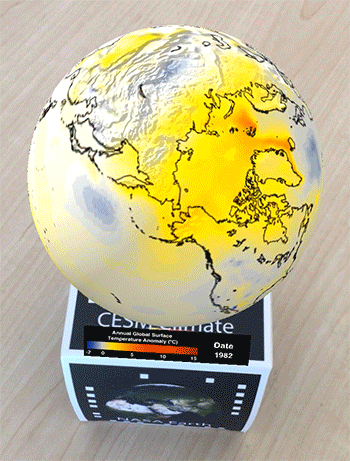Annual report highlights CISL's FY2017 successes
NCAR’s Computational and Information Systems Laboratory (CISL) structures its plans and operates its projects to provide world-class service, science, and education for the Earth System sciences research community. CISL operates NCAR’s supercomputing and data services that are tailored to the atmospheric, geospace, and related science communities including more than 1,700 users at more than 330 universities and other institutions. CISL also produces broader impacts in the community by providing leadership in high performance computing and diversifying the nation’s research workforce. CISL’s Fiscal Year 2017 Annual Report highlights the broad scope and high quality of the lab’s contributions and successes in all of these areas.
Again during FY2017, CISL staff produced standout accomplishments that support all three of its strategic goals in service, science, and education.

Developed by a CISL intern, the Meteo AR app uses augmented-reality techniques to make atmospheric science data more accessible to the public. The cardboard cube shown in this image and the smartphone app that accesses the data are being distributed to wide range of people from the public, to technology developers, to scientists visiting NCAR, the NWSC, and NCAR's exhibit booths at international conferences. A more extensive video demonstration appears on YouTube.
Service
Computing is a foundational element of scientific research, and CISL provides a portfolio of advanced computing and data services specifically tailored for the atmospheric, geospace, and related sciences communities. At its core, CISL is a laboratory dedicated to providing advanced cyberinfrastructure to advance world-class science. CISL’s service portfolio includes cyberinfrastructure, user support, big data, and information technology. CISL’s service highlight for FY2017 was the installation and transition to operations of the Cheyenne supercomputer with all of its supporting infrastructure. Years of detailed planning by CISL staff directed all of the associated preparation, logistics, and labor toward the successful operation of this new system. NCAR continues to provide a productive, world-class supercomputing facility that supports the scientific goals of numerous research communities, and the 5.3-petaflops Cheyenne supercomputer enables another four years of scientific discovery.
Science
The scientific research conducted by CISL combines petascale supercomputing resources with the latest computational science research in algorithms, mathematical techniques, and statistical methods applied to Earth System science. CISL’s research activities in FY2017 supported scientific computation, numerical methods development, geophysical modeling, plus geophysical data and model experiments that advanced our knowledge about the Earth System. Our activities helped the geophysics community adopt new computational methods and mathematical tools to improve research. This year’s accomplishments in data-centric research include an important new release of the Data Assimilation Research Testbed (DART), improvements in climate adaptation planning for the U.S. West and various U.S. military bases, and a new model for climate change detection and attribution. Further, CISL combines science and education through research and technical collaborations using a focused visitor program and research-oriented workshops and seminars.
Education
All of CISL’s educational and training efforts are designed to complement and supplement programs at universities and other centers. Educational events continued to bring new interns, students, mathematicians, data scientists, and computer scientists to NCAR, and these led to new collaborations, influenced graduate student research, and enriched our staff. All of these events also focused on helping our scientific and technical communities cope with the Big Data challenges of today’s research environment. CISL continued to integrate research and education through internships, externships, and educational activities for college and university faculty. CISL provides training for researchers in the atmospheric and related sciences to help them improve their use of NCAR’s petascale computing and data resources, and this training includes curricula in supercomputing, data analysis, and visualization for scientists and interns. CISL’s outreach efforts actively attracted qualified candidates – particularly those from diverse backgrounds – to our research enterprise and allowed us to enrich our workforce while increasing its diversity.
CISL’s yearly annual reports highlight its most recent contributions and successes in all of these areas. Please review CISL’s FY2017 Annual Report to learn about the work we do and what we’ve accomplished in the past year.